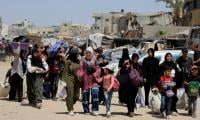On top of the adverse global and national developments in a post-pandemic world, Sindh and Balochistan got severely hit by extraordinary torrential rains in a short interval of time.
During this time, the average rainfall received was 1100 mm — five times the normal. According to the Sindh chief minister, flooding from Balochistan amounted to 120 maf of flood water equivalent to the capacity of multiple Tarbela Dams. The dysfunctional or nonexistent drainage system contributed to the miseries of the people as large swathes of land on both the left and right bank are still inundated. The upcoming wheat cultivation seems difficult in these areas.
The floods have devastated and displaced above 33 million people, submerged their homes, destroyed their livestock and their cultivated crops, damaged infrastructure and irrigation network, killed more than 1100 people, and caused a loss of $30 billion or 10 per cent of GDP. The infrastructure through which the produce is marketed has been severely damaged, and the seeds for the next crops have been washed away. These losses were relatively more widespread in the right bank districts. This provides ample testimony that global warming has already begun to make its pernicious impact.
The World Bank’s latest assessment (PDNA) estimates total damages to exceed $14.9 billion, and total economic losses to reach about $15.2 billion. The estimated needs for rehabilitation and reconstruction in a resilient way are at least $16.3 billion, not including the much-needed new investments beyond the affected assets, to support Pakistan’s adaptation to climate change and overall resilience of the country to future climate shocks. Housing; agriculture and livestock; and transport and communications sectors suffered the most significant damage, at $5.6 billion, $3.7 billion, and $3.3 billion, respectively. Sindh is the worst affected province with close to 70 per cent of total damages and losses, followed by Balochistan, Khyber Pakhtunkhwa, and Punjab.
There are stagnant flood waters in many areas, causing water-borne and vector-borne diseases to spread, and more than eight million displaced people are now facing a health crisis. The PDNA Human Impact Assessment highlights that the poverty rate in Sindh may increase by 8.7-9.7 percentage points, potentially pushing between four and five million more people below the poverty line. Multidimensional poverty in Sindh can potentially increase by 10.2 percentage points, implying that an additional 1.2 million households are at risk of being pushed into non-monetary poverty.
Loss in GDP as a direct impact of the floods is projected to be around 2.2 per cent of FY22 GDP. The agriculture sector is projected to contract the most, at 0.9 per cent of GDP. The damage and loss in agriculture will have spillover effects on the industry, external trade and services sectors. Affected districts have a higher proportion of employment in agriculture compared to the national average. Job losses would consequently be relatively high. Around 8.2 million people in Sindh are food insecure and the number is likely to rise by another two to three million as access to food becomes limited if the wheat crop targets for sowing are not met.
The report shows that the burden has fallen disproportionately upon the rural population of Sindh. The damage and loss for Sindh is calculated at $20.4 billion out of the national estimate of $30.1 billion. The needs for rehabilitation and reconstruction for Sindh (excluding cross-provincial) amount to $7.9 billion. The poverty rate and multidimensional poverty rates — which were quite high before the pandemic and the floods — have worsened and output losses in provincial income, particularly in agriculture and allied activities, are likely to be much larger than the national average, registering a negative growth rate. So, the requirement for emergency cash assistance has also increased substantially.
The crisis thus risks having a profound and lasting impact on lives and livelihoods. The impact on household welfare will come through at least four channels: (i) loss of household income and employment/livelihoods due to destroyed harvest, killed livestock, or inactivity of businesses; (ii) loss of assets, including homes, livestock, productive equipment, and household durables; (iii) rising food prices due to shortages of food arising from lost food stocks and poor harvests; and (iv) loss of human capital, given the significant threat of disease outbreaks and food shortages, and prolonged school closures, with attendant learning losses.
Loss of household incomes, assets, rising food prices, and disease outbreaks are impacting the most vulnerable groups. The rural women of Sindh, already at a serious economic and social disadvantage compared to urban men, have suffered notable losses of their livelihoods, particularly those associated with agriculture and livestock. Forty-nine per cent of those affected by the floods were women involved in farming, tending livestock, harvesting crops and collecting fuel wood. When destructive events occur, women’s employment and earnings are highly impacted as they do not receive enough assistance to find alternate means of livelihood. Inflation in rural areas — that has already increased from 4.8 per cent in January 2022 to 38 per cent in July — is going to hit the women as their subsistence food has been destroyed and they have to buy food from the market.
A latest satellite-based assessment conducted by researchers at the International Centre for the Integrated Mountain Division (ICIMOD) forecast that flood waters would likely reduce Sindh’s cotton crop by 88 per cent, rice 80 per cent, sugarcane by 61 per cent. Two million bales of cotton have been destroyed in Sindh province, losses of $3 billion on the cotton value chain. Minor and major crops standing over million acres have been affected besides inflicting huge losses to livestock. Infectious diseases are spreading and food shortage looming amidst vast swathes of farmland remaining waterlogged.
Pakistan will have a population of 350 million people by 2050 who will have to be fed, clothed, sheltered and gainfully employed in an environment where production of staple food, crops, generation of electricity and availability of water are likely to be declining. The increased population’s overall food demand will expand by 50 per cent. This implies that 56 per cent additional crop calories have to be grown compared to what was being produced in 2010. The challenge is how to meet the future land and water requirements without deforestation while also bringing more area under reforestation and adapting and mitigating the climate risks, providing livelihood and reducing poverty. Water availability is likely to recede to extremely stressful levels while the demand for meat, milk and poultry would rise by 50 per cent because of rising income and increase in population. Urbanization is already pushing people out of agriculture and land is being used for housing, commercial and industrial purposes.
These external shocks have precipitated a disastrous situation, especially for the marginalized rural population in Sindh — and future recurrence cannot be ruled out. Which is why some rethinking is required on the part of the federal and provincial governments, local communities, and donor agencies to meet future contingencies. Of course, macroeconomic stabilization has to be the top priority but policy interventions have to be targeted at the most vulnerable and poor segments of the population in the affected districts.
Political economy considerations which end up benefiting the powerful and influential elites have to be set aside and the welfare of the suffering people has to be maximized. This is easier said than done but the magnitude of the problem this time is huge and the future developments due to climate change risks do not augur well. The parochial interests of the few powerful and influential elites have to be taken care of by themselves rather than diverting the scarce public resources to benefit them.
To be continued
The writer is the author of 'Governing the ungovernable'.
Protesters allege that Prime Minister Sheikh Hasina Wajid is playing a double game
Although Pakistan became an active part of Western bloc, Islamabad adopted a principled position on several...
Trump has been leading on most opinion polls, particularly since the debate that badly exposed Biden
Democracy has been declining in America for decades, especially under the impact of money and media
At heart of these events lies the phenomenon of overtourism
General Zia, perceiving student unions as potent adversaries, imposed a ban on February 9, 1984







